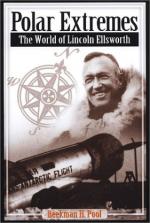|
This section contains 345 words (approx. 2 pages at 300 words per page) |
Encyclopedia of World Biography on Lincoln Ellsworth
Lincoln Ellsworth (1880-1951), American adventurer and explorer, became the first man to cross both the Arctic and the Antarctic by air.
The son of a wealthy businessman and financier, Lincoln Ellsworth was born in Chicago on May 12, 1880. Graduating from preparatory school in 1900, he briefly attended Yale and Columbia universities, but his real interest was in outdoor life. He traveled extensively, working in Canada and Alaska as a railroad surveyor and mining engineer. He then formally studied practical astronomy and surveying in preparation for realizing his lifelong ambition--polar exploration.
A true adventurer, Ellsworth participated in the Canadian government's buffalo hunt of 1911, prospected for gold, spent 3 years with the U.S. Biological Survey on the Pacific coast, and volunteered for service in World War I, training as a pilot in France. Following the war and a protracted illness, Ellsworth in 1924 joined a geological expedition to Peru.
The following year Ellsworth joined and largely financed the expedition with Roald Amundsen, the Norwegian explorer, that initiated Arctic exploration by air. Flying from Spitsbergen for the North Pole in two planes, the party of six reached 87° 44N before being forced down with engine trouble. One plane was badly damaged during the landing, and it took 3 weeks to get the other plane off the polar ice pack. They returned to Spitsbergen to announce that no land existed on the European side of the pole. In 1926 Amundsen and Ellsworth returned to the Arctic, this time with a semirigid airship, the Norge.
Ellsworth concentrated on geologic work in the American Southwest for several years, although in 1931 he represented the American Geographic Society on the Arctic flight of the Graf Zeppelin. He undertook the exploration of Antarctica by air in 1933. In 1935, on his third attempt, Ellsworth and his pilot crossed Antarctica, landing 16 miles short of Richard Byrd's abandoned camp at Little America, where they were rescued. On this and a subsequent flight in 1939 Ellsworth discovered and claimed for the United States 377,000 square miles of land.
Ellsworth was a bold, imaginative, superbly conditioned man. He died in New York City on May 26, 1951.
|
This section contains 345 words (approx. 2 pages at 300 words per page) |


